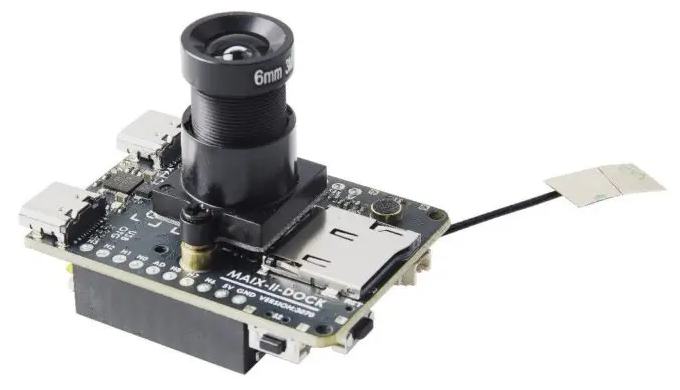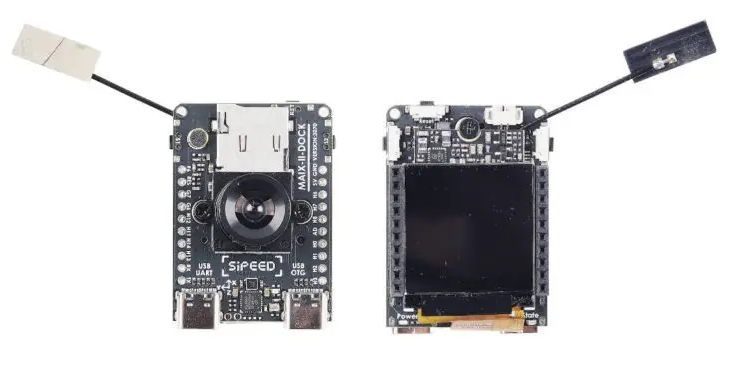Sipeed MAIX-II Dock: An Allwinner V831 Powered AIoT Vision Devkit
The MAIX-II Dock has a even higher resolution and fps than MAIX-I

Sipeed introduced MAIX development boards powered by Kendryte K210 dual-core RISCV processor with AI accelerators in 2018, and we tested the Maixduino and Grove AI HAT based on the solution using Arduino and Micropython the following year. It works fine for audio and video project requiring AI acceleration at low power, but performance (resolution/fps) is limited.
So if you’d like a bit more oomph for your audio & vision AI projects, as well as proper Linux support, Sipeed has just launched MAIX-II Dock powered by Allwinner V831 Cortex-A7 AI camera SoC clocked at up to 800-1000 MHz and 64MB on-chip DDR2 RAM, as well as a Full HD camera and a small display.
MAIX-II Dock Specifications:
-
MAIX-II Core Module
- SoC – Allwinner V831 single-core Cortex-A7 processor clocked at 800-1000 MHz with 0.2TOPS (NVDLA) AI accelerator, H.264/H.265/JPEG video encoder up to 1080p30
- System Memory – 64MB DDR2 in package (SiP)
- Storage – Optional 16MB flash
- M.2 B-Key edge connector with
- Storage – 2x SD/MMC host controller(SMHC) interfaces.
- Camera – 2-lane MIPI up to 1080p60
- Display – Support for 8-bit MCU LCD and up to 10-inch RGB LCD via an adapter board
- Networking – 10/100M Ethernet
- Audio – Line Out, Mic In
- Low-speed I/Os – 2x SPI, 4x I2C, 1x I2S, 1-channel 6-bit LRADC for keys
- Power consumption – 50mA (idle); Voltage not speficied, probably 5V.
- Dimensions – 22.1 x 24.9 x 3.0 mm
-
MAIX-II Dock “Baseboard”
- M.2 Key socket for MAIX-II core module
- Storage – 1x MicroSD card slot
- Display – 1.3-inch IPS screen with a 240×240 resolution
- Camera – 1080p30 camera based on Omnivision SP2305 2MP sensor and 6mm focal length M12 lens by default
- Audio – Built-in 8Ω 1W speaker connected to 2-pin header, built-in microphone
- Connectivity – Realtek RTL8189FTV WiFi 4 module connected via SDIO, plus IPEX antenna connector
- USB – 2x USB Type-C ports, one OTG port, one for debugging via GD32F150G8 chip.
- Sensor – 3-axis accelerometer
- Expansion – 2x 10-pin female headers for I/Os (2.54mm pitch)
- Misc – Power and user LEDs, Reset button, 2x user buttons,
- Power Supply – 5V via either USB-C ports
- Power Consumption – 490mA under load (NPU + display + camera + WiFi)
- Dimensions – Full kit: 48.9 x 33.9 x 36.1 mm
If you’ve ever worked with one of Sipeed MAIX-I (K210) platforms using MicroPython, software development on MAIX-II (V831) will feel similar, except for the higher resolution and/or frame rate.
The company provides the OpenWrt based MAIX-LINUX firmware adapted for edge computing, including the relevant drivers, and all opkg package source code will be provided, as well as code samples. The board is programmed using Python 3.8.5 using customs MAIX NPU acceleration packages, and with a similar web interface as the original MAIX boards. Sadly, documentation is lacking right now, and all we are offered is a web mirror with some directories for Linux, packages, etc…
Note that while the overall system performance is much higher, the AI performance may be similar as both Kendryte K210 and Allwinner V831 include a ~0.2 TOPS AI accelerator. But do not despair as Sipeed is already working on the third generation MAIX hardware, and recently teased us with MAIX-III powered by a new (Rockchip?) processor with A 1.5TOPS NPU (vip9000) and the platform, scheduled for release in February 2021, will also come with dual-band WiFi, Gigabit Ethernet, and 512MB to 2GB DDR3.








